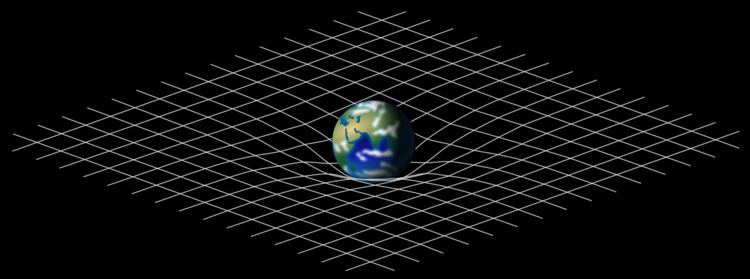 | ||
In differential geometry, the Einstein tensor (named after Albert Einstein; also known as the trace-reversed Ricci tensor) is used to express the curvature of a pseudo-Riemannian manifold. In general relativity, it occurs in the Einstein field equations for gravitation that describe spacetime curvature in a manner consistent with energy and momentum conservation.
Contents
Definition
The Einstein tensor
where
The Einstein tensor is symmetric
and, like the stress–energy tensor, divergenceless
Explicit form
The Ricci tensor depends only on the metric tensor, so the Einstein tensor can be defined directly with just the metric tensor. However, this expression is complex and rarely quoted in textbooks. The complexity of this expression can be shown using the formula for the Ricci tensor in terms of Christoffel symbols:
where
Before cancellations, this formula results in
In the special case of a locally inertial reference frame near a point, the first derivatives of the metric tensor vanish and the component form of the Einstein tensor is considerably simplified:
where square brackets conventionally denote antisymmetrization over bracketed indices, i.e.
Trace
The trace of the Einstein tensor can be computed by contracting the equation in the definition with the metric tensor
The special case of n = 4 dimensions in physics (3 space, 1 time) gives
Use in general relativity
The Einstein tensor allows the Einstein field equations (without a cosmological constant) to be written in the concise form:
which becomes in geometrized units (i.e. c = G (i.e. the Newton's gravitational constant and NOT the trace of the Einstein tensor !) = 1),
From the explicit form of the Einstein tensor, the Einstein tensor is a nonlinear function of the metric tensor, but is linear in the second partial derivatives of the metric. As a symmetric order-2 tensor, the Einstein tensor has 10 independent components in a 4-dimensional space. It follows that the Einstein field equations are a set of 10 quasilinear second-order partial differential equations for the metric tensor.
The Bianchi identities can also be easily expressed with the aid of the Einstein tensor:
The Bianchi identities automatically ensure the covariant conservation of the stress–energy tensor in curved spacetimes:
The physical significance of the Einstein tensor is highlighted by this identity. In terms of the densitized stress tensor contracted on a Killing vector
Uniqueness
David Lovelock has shown that, in a four-dimensional differentiable manifold, the Einstein tensor is the only tensorial and divergence-free function of the
However, the Einstein field equation is not the only equation which satisfies the three conditions:
- Resemble but generalize Newton–Poisson gravitational equation
- Apply to all coordinate systems, and
- Guarantee local covariant conservation of energy–momentum for any metric tensor.
Many alternative theories have been proposed, like Einstein–Cartan theory, etc... that also satisfy the above conditions.
